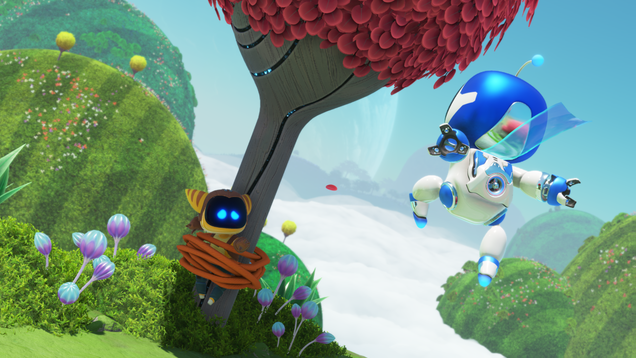
I can’t remember the last time I played a PlayStation game and felt this happy. I’ve loved plenty of first-party Sony games and their expensive melding of Hollywood cinematics, refined gameplay, and dense systems. Astro Bot is in many ways the antithesis of that. It’s no less refined, perhaps even more so. And it certainly doesn’t look or feel cheap. But it does play like a game unsaddled from the self-conscious baggage of an industry chasing the emotional weight of prestige TV and the content expectations of $300 million blockbusters. Astro Bot is whimsical, delightful, and most importantly, just a whole lot of fun.
I played four levels and some extra challenge stages from the upcoming PlayStation 5 action platform at Summer Game Fest. It took roughly 45 minutes with Team Asobi’s latest crack at the burgeoning robot series—which arrives September 6—for me to become completely Astro Bot-pilled. I didn’t play 2018’s Astro Bot Rescue Mission for PlayStation VR, and only briefly dabbled in the PS5 launch pack-in game Astro’s Playroom, despite enjoying what I tried and the near-unanimous praise it received. My time with the upcoming sequel, arguably the mascot’s first, full-fledged adventure, convinced me the Mario-inspired formula isn’t just ready for primetime but could become the next great series in Sony’s PlayStation Studios repertoire.
Astro Bot will feature over 80 levels across 50 planets in six different galaxies. The goal of each one is to rescue over 150 fellow bots that represent characters from PlayStation’s past and present, like God of War’s Kratos and Jak from Jak and Daxter. The stages I played were each fairly short and linear, but that didn’t matter. Every moment was bursting with satisfying animations or rewarding discoveries. While Mario Bros. levels and feel like mazes where abilities and secrets help you to unlock them, Astro Bot stages are like a children’s museum design to maximize sensory experience.
They begin with you flying in and crash landing on a “Dual Speeder” ship that looks exactly like a DualSense. As Astro’s means of transportation, the controller is also the key vehicle for everything that happens in the game, with sounds from the speaker, minor variations in the rumble, and the haptic feedback of the triggers all working in concert to imbue every enemy punched, coin collected, and object broken with a sense of pure joy. You know something’s really working when you pick up a new power, in this case the bulldog Barkster’s air dash, and you can’t stop using it. I just kept pressing it over and over again, whether I needed to or not, because I could and it felt amazing, even if I accidentally killed myself a few times along the way.
Another part of Astro Bot’s magic is that, at least in my demo of the game, none of these sensory tricks, visual flourishes, or gameplay gimmicks felt overused. Once the level was done, the air dash went away and was replaced with something else. At five to 10 minutes each, the ideas in one stage are quickly exhausted before moving on to the next batch. I unzipped a big pink octopus one moment and crashed into paint buckets the next. A construction level had me collecting metal bars with a magnet to move platforms. A giant fishbowl smashed and let the water out on another. Along the way I missed plenty of bots, so I by no means exhausted each level, but the bite-sized experiences left me wanting to go back, rather than worrying about the potential tedium of an overstuffed collectible hunt.
The fact that each bot represents a part of PlayStation’s history felt surprisingly alluring too. Those Easter Eggs feel more like a bonus than a crutch. Instead of relying on nostalgia and winking at hardcore fans, gathering characters from the platform’s past gives the collectibles added meaning. Each new bot, like one based on the protagonist of Journey, is like a walk down memory lane, including visiting past console eras where games like Astro Bot didn’t feel so rare. While past Astro games served as tech demos and museums, the platforming, presentation, and world design of Astro Bot feel strong enough for the game to stand on its own, even if it wasn’t bathed in gamer nostalgia.
My hands-on time ended with a boss fight against a giant octopus where I used frog arms to punch it and slingshot Astro into its head. A second phase had me jumping across platforms and swinging from red beams in between massive waves crashing across the cliffs from which I was hanging. After that, I made my way to a challenge stage where everything moved super-fast until canisters of exploding ice were used to slow down the environment. It was the perfect digestive on which to end a delicious and filling meal. There was just enough challenge to make me lean forward, but not so much that my glee turned to frustration. The PlayStation reps watching behind me were kind enough to cheer when I finally cleared it after half a dozen attempts.
This is the part where I remind you that I’ve only played small portion of the game via a carefully staged demo, and my impressions are limited to that fairly scripted slice. Still, if the rest of the game is anything like it, Astro Bot could be something pretty special. And it’s definitely a dose of breezy but mischievous fun the PS5 needs right now.

